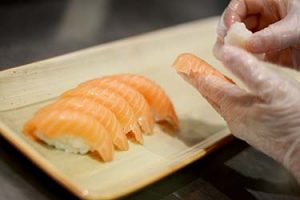Our raw materials
Our fish
Only the best is good enough for us and our customers. That's why we buy all our fish from Kvalitetsfisk.
Salmon
Our salmon comes exclusively from Norway, of the Salmon superior class and is delivered fresh to our restaurants. As winter approaches, most of it comes from the fjords around Bergen in southern Norway and during the summer months it comes mostly from northern Norway.
Farmed salmon does not need to be frozen before being eaten raw according to the Swedish Food Agency. At Saya Sushi we always freeze the salmon for safety reasons and as an additional precaution for safe food.
One kilo of salmon requires 1.1 kg of feed. By comparison, cattle require 8 kg of feed for one kilo of beef. This makes salmon a good and sustainable option.
Tuna
Our yellowfin tuna comes from the Maldives and is sustainably fished, quota fished. The method is called 'pole and line', meaning that only one tuna is caught at a time, making fishing very gentle with almost no by-catch. Should unwanted fish be caught, they can be released back into the water unharmed. Factsheet Yellowfin tuna.
Our meat
Our chicken and minced meat come from Sweden. Yakiniku meat from Poland.
Black rice
Black rice is better than white rice, which is mostly carbohydrates. Black rice retains the healthy bran layer which contains beneficial dietary fibers, vitamins, minerals and protein. In addition, the black dye is rich in anthocyanins, an antioxidant, which helps to prevent atherosclerosis and DNA damage (protecting our arteries and preventing cell damage) that can lead to cancer.
Take away products
We have switched our operations to more sustainable alternatives and are constantly working to improve. We buy our disposable items from Tingstad which guarantees that all their food packaging is environmentally friendly and has one or more environmental characteristics such as fossil-free plastic or FSC labeling.
PureFiberTM
The products are manufactured using a completely new technology where the wood pulp fiber is extracted and then molded. The material makes it possible to produce food-friendly products without a plastic barrier. 100% renewable raw material, produced from Scandinavian and certified forests,
75% lower carbon footprint than similar food molds, high recyclability.
Bamboo
This material is fast growing and requires little water and no pesticides during cultivation. If you compare the growth rate with an oak tree, for example, it takes about 50 years for the tree to grow up and 4-6 years before bamboo can be felled.
Bagasse
Bagasse is the residual fiber material left over from sugar production.
Palm leaf
Disposable palm leaf products are made from fallen palm leaves. The leaves are cleaned and then pressed into different shapes. No chemical additives are needed and each product is unique.
Wheat straw
Wheat straw is left over from harvesting wheat grains. They can then be recycled and the material can be used to make paper-like products such as plates.
wood
Cultivated birch which is a renewable raw material. Decomposition time is 60-90 days.



